Effects of Low-Pressure Systems on Temperature, Humidity, Egg Production, and Feed Utilization Efficiency in Large-Scale Poultry Houses during Summer
Abstract
:Simple Summary
Abstract
1. Introduction
2. Materials and Methods
2.1. Poultry Housing
2.2. Ventilation and Environmental Control Mode
2.3. LPS Conditions
2.4. Temperature and Humidity on LPSs and Other Days
2.5. Percentage of Weekly Time with Indoor Air Temperature above x °C
2.6. Temperature–Humidity Heat Stress Index (THI)
2.7. Egg Production Condition
2.8. Feed Utilization Efficiency
2.9. Statistical Analysis
3. Results
3.1. Effect of LPSs on Air Temperature and Relative Humidity
3.2. Effect of LPSs on Wt27, Wt28, Wt29, and Wt30
3.3. Effect of LPSs on THI
3.4. Effect of LPSs on the EPR and AEW
3.5. Effect of LPSs on Feed Utilization Efficiency
4. Discussion
5. Conclusions
Author Contributions
Funding
Institutional Review Board Statement
Informed Consent Statement
Data Availability Statement
Acknowledgments
Conflicts of Interest
References
- You, Y.; Ting, M. Low pressure systems and extreme precipitation in southeast and east Asian monsoon regions. J. Clim. 2021, 34, 1147–1162. [Google Scholar] [CrossRef]
- Huang, G.; Chen, S. Analysis of temporal and spatial evolution characteristics of rainfall structure in the Pearl River Delta area under background of high urbanization. W. Resour. Prot. 2022, 38, 82–90. [Google Scholar]
- Tran, T.X. Typhoon and agricultural production portfolio empirical evidence for a developing economy. Int. J. Disaster Risk Reduct. 2022, 75, 102938. [Google Scholar] [CrossRef]
- Philippines National Disaster Risk Reduction and Management Council (NDRRMC). NDRRMC Update: Situation Report No. 57 Re–Preparedness Measures and Effects for Typhoon “Ompong” (I.N. Mangk Hut); NDRRMC: Quezon City, Philippines, 2018. [Google Scholar]
- Rasool, S.; Sa, H.; Ayman, N.; Fayaz, A.; Shubeena, S.; Thahaby, N.; Nabi, B.; Hai, A.; Ah, A. The impact of natural disasters on livestock sector: A review. J. Biomed. Res. Environ. Sci. 2021, 2, 669–674. [Google Scholar] [CrossRef]
- Hsiu–Yin Lin. Minister of Agriculture and Rural Affairs of China. Available online: https://www.moa.gov.tw/ws.php?id=20173 (accessed on 17 September 2009).
- Mohan, P. Impact of hurricanes on agriculture: Evidence from the Caribbean. Nat. Hazards Rev. 2017, 18, 04016012. [Google Scholar] [CrossRef]
- Wang, J.; Guo, B.; Zhao, K.; Che, Y.; Mantravadi, V.S. Effects of Typhoon Chanthu on marine chlorophyll a, temperature and salinity. Atmosphere 2023, 14, 1505. [Google Scholar] [CrossRef]
- Roux, F.; Clark, H.; Wang, K.-Y.; Rohs, S.; Sauvage, B.; Nédélec, P. The influence of typhoons on atmospheric composition deduced from IAGOS measurements over Taipei. Atmos. Chem. Phys. 2020, 20, 3945–3963. [Google Scholar] [CrossRef]
- Kanada, S.; Aiki, H. Buffering effect of Atmosphere–Ocean coupling on intensity changes of tropical cyclones under a changing climate. Geophys. Res. Lett. 2024, 51, e2023GL105659. [Google Scholar] [CrossRef]
- Park, G.; Lee, I.; Yeo, U.; Ha, T.; Kim, R.; Lee, S. Ventilation rate formula for mechanically ventilated broiler houses considering aerodynamics and ventilation operating conditions. Biosyst. Eng. 2018, 175, 82–95. [Google Scholar] [CrossRef]
- Oliveira, J.L.; Ramirez, B.C.; Xin, H.; Wang, Y.; Hoff, S.J. Ventilation performance and bioenergetics of dekalb white hens in a modern aviary system. Biosyst. Eng. 2020, 199, 149–161. [Google Scholar] [CrossRef]
- Forman, S.; Hungerford, N.; Yamakawa, M.; Yanase, T. Climate change impacts and risks for animal health in Asia. Rev. Sci. Tech. 2008, 27, 1–17. [Google Scholar] [CrossRef]
- Yahav, S.; Shinder, D.; Razpakovski, V.; Rusal, M.; Bar, A. Lack of response of laying hens to relative humidity at high ambient temperature. Br. Poult. Sci. 2000, 41, 660–663. [Google Scholar] [CrossRef]
- Samli, H.E.; Agma, A.; Senkoylu, N. Effects of storage time and temperature on egg quality in old laying hens. J. Appl. Poult. Res. 2005, 14, 548–553. [Google Scholar] [CrossRef]
- Squibb, R.L.; Wogan, G.N.; Reed, C.H. Production of white leghorn hens subjected to high environmental temperatures with wide diurnal fluctuations. Poul. Sci. 1959, 38, 1182–1183. [Google Scholar] [CrossRef]
- Al-Saffar, A.A.; Rose, S.P. Ambient temperature and the egg laying characteristics of laying fowl. Worlds Poult. Sci. J. 2002, 58, 317–331. [Google Scholar] [CrossRef]
- Kampen, M. Thermal influences on poultry. In Environmental Aspects of Housing for Animal Production; Butterworths: London, UK, 1981; pp. 131–147. ISBN 978-1-4831-6433-5. [Google Scholar]
- Lysenko, V.; Golovinskiy, B.; Reshetyuk, V.; Golub, B.; Shcherbatyuk, V. Dynamics of quality indexes of laying hens keeping process due to fluctuations of temperature disturbances in an industrial poultry house. Ann. Wars. Univ. Life Sci.—SGGW Agric. 2011, 57, 79–92. [Google Scholar]
- Wahid, Z.A.; Ratriyanto, A.; Prastowo, S. The effect of betaine supplementation on performance of laying hens in the tropical climate during the starting period. IOP Conf. Ser. Earth Environ. Sci. 2021, 902, 012043. [Google Scholar] [CrossRef]
- Rozenboim, I.; Tako, E.; Gal-Garber, O.; Proudman, J.A.; Uni, Z. The effect of heat stress on ovarian function of laying hens. Poul. Sci. 2007, 86, 1760–1765. [Google Scholar] [CrossRef]
- Webster, A.; Czarick, M. Temperatures and performance in a tunnel-ventilated, high-rise layer house. J. Appl. Poult. Res. 2000, 9, 118–129. [Google Scholar] [CrossRef]
- Emmans, G.; Charles, D. Climatic environment and poultry feeding in practice. In Recent Developments in Poultry Nutrition; Butterworths: London, UK, 1989; pp. 212–230. ISBN 978-0-407-01513-2. [Google Scholar]
- Elijah, O.A.; Adedapo, A. The Effect of climate on poultry productivity in Ilorin Kwara State, Nigeria. Int. J. Poult. Sci. 2006, 5, 1061–1068. [Google Scholar]
- Wang, Y.; Zheng, W.; Li, B.; Li, X. A new ventilation system to reduce temperature fluctuations in laying hen housing in continental climate. Biosyst. Eng. 2019, 181, 52–62. [Google Scholar] [CrossRef]
- Yang, N.; Wu, C. New Mathematical model of poultry egg production. Poul. Sci. 1989, 68, 476–481. [Google Scholar] [CrossRef]
- Hui, X.; Li, B.; Xin, H.; Zheng, W.; Shi, Z.; Yang, X.; Zhao, S. New control strategy against temperature sudden-drop in the initial stage of pad cooling process in poultry houses. Int. J. Agric. Biol. Eng. 2018, 11, 66–73. [Google Scholar] [CrossRef]
- Zheng, W.; Xiong, Y.; Gates, R.S.; Wang, Y.; Koelkebeck, K.W. Air temperature, carbon dioxide, and ammonia assessment inside a commercial cage layer barn with manure-drying tunnels. Poul. Sci. 2020, 99, 3885–3896. [Google Scholar] [CrossRef]
- Olgun, M.; Çelik, M.Y.; Polat, H.E. Determining of heat balance design criteria for laying hen houses under continental climate conditions. Build. Environ. 2007, 42, 355–365. [Google Scholar] [CrossRef]
- Wang, Y.; Zheng, W.; Shi, H.; Li, B. Optimising the design of confined laying hen house insulation requirements in cold climates without using supplementary heat. Biosyst. Eng. 2018, 174, 282–294. [Google Scholar] [CrossRef]
- Wang, C.; Cao, W.; Li, B.; Shi, Z.; Geng, A. A fuzzy mathematical method to evaluate the suitability of an evaporative pad cooling system for poultry houses in China. Biosyst. Eng. 2008, 101, 370–375. [Google Scholar] [CrossRef]
- Kang, S.; Kim, D.-H.; Lee, S.; Lee, T.; Lee, K.-W.; Chang, H.-H.; Moon, B.; Ayasan, T.; Choi, Y.-H. An acute, rather than progressive, increase in temperature-humidity index has severe effects on mortality in laying hens. Front. Vet. Sci. 2020, 7, 568093. [Google Scholar] [CrossRef] [PubMed]
- Kim, D.-H.; Lee, Y.-K.; Kim, S.-H.; Lee, K.-W. The impact of temperature and humidity on the performance and physiology of laying hens. Animals 2021, 11, 56. [Google Scholar] [CrossRef]
- Li, B.; Wang, Y.; Rong, L.; Zheng, W. Research progress on animal environment and welfare. Anim. Res. One Health 2023, 1, 78–91. [Google Scholar] [CrossRef]
- Shi, Z.; Li, X.; Wang, T.; Xi, L.; Cheng, P.; Fang, M.; Liu, W. Application effects of three ventilation methods on swine in winter. Agron J. 2022, 114, 1915–1922. [Google Scholar] [CrossRef]
- Kim, D.-H.; Kim, Y.-B.; Lee, S.H.; Lee, Y.-K.; Lee, S.-D.; Lee, K.-W. Identical thermal stress coupled with different temperature and humidity combinations affects nutrient digestibility and gut metabolites of laying hens. R. Bras. Zootec. 2023, 52, e20220067. [Google Scholar] [CrossRef]
- Campos, A.; Wilcox, F.; Shaffner, C. The influence of fast and slow drops in ambient temperature on egg production traits. Poult. Sci. 1962, 41, 856–865. [Google Scholar] [CrossRef]
- Li, T.; Wei, H.; Zhang, S.; Liu, X.; Xing, L.; Liu, Y.; Gong, R.; Li, J. Intermittent cold stimulation affects energy metabolism and improves stress resistance in broiler heart. Poul. Sci. 2024, 103, 103190. [Google Scholar] [CrossRef]
- Koskela, H.O. Cold air-provoked respiratory symptoms: The mechanisms and management. Int. J. Circumpolar Health 2007, 66, 91–100. [Google Scholar] [CrossRef]
- Oguntunji, A.O.; Alabi, O.M. Influence of high environmental temperature on egg production and shell quality: A review. Worlds Poult. Sci. J. 2010, 66, 739–750. [Google Scholar] [CrossRef]
- Yoshida, N.; Fujita, M.; Nakahara, M.; Kuwahara, T.; Kawakami, S.-I.; Bungo, T. Effect of high environmental temperature on egg production, serum lipoproteins and follicle steroid hormones in laying hens. J. Poult. Sci. 2011, 48, 207–211. [Google Scholar] [CrossRef]
- Mignon-Grasteau, S.; Moreri, U.; Narcy, A.; Rousseau, X.; Rodenburg, T.B.; Tixier-Boichard, M.; Zerjal, T. Robustness to chronic heat stress in laying hens: A meta-analysis. Poult. Sci. 2015, 94, 586–600. [Google Scholar] [CrossRef]
- Barrett, N.W.; Rowland, K.; Schmidt, C.J.; Lamont, S.J.; Rothschild, M.F.; Ashwell, C.M.; Persia, M.E. Effects of acute and chronic heat stress on the performance, egg quality, body temperature, and blood gas parameters of laying hens. Poul. Sci. 2019, 98, 6684–6692. [Google Scholar] [CrossRef]
- Adams, C.J.; Bell, D.D. A Model Relating Egg Weight and distribution to age of hen and season. J. Appl. Poult. Res. 1998, 7, 35–44. [Google Scholar] [CrossRef]
- Perini, F.; Cendron, F.; Rovelli, G.; Castellini, C.; Cassandro, M.; Lasagna, E. Emerging genetic tools to investigate molecular pathways related to heat stress in chickens: A review. Animals 2020, 11, 46. [Google Scholar] [CrossRef] [PubMed]
- Alves, F.; Felix, G.; Almeida Paz, I.; Naeaes, I.; Souza, G.; Caldara, F.; Garcia, R. Impact of exposure to cold on layer production. Braz. J. Poult. Sci. 2012, 14, 223–226. [Google Scholar] [CrossRef]
- Eltahan, H.M.; Kang, C.W.; Chowdhury, V.S.; Eltahan, H.M.; Abdel-Maksoud, M.A.; Mubarak, A.; Lim, C.I. Cold drinking water boosts the cellular and humoral immunity in heat-exposed laying hens. Animals 2023, 13, 580. [Google Scholar] [CrossRef]
- Xing, S.; Wang, X.; Diao, H.; Zhang, M.; Zhou, Y.; Feng, J. Changes in the cecal microbiota of laying hens during heat stress is mainly associated with reduced feed intake. Poul. Sci. 2019, 98, 5257–5264. [Google Scholar] [CrossRef]
- Star, L.; Kemp, B.; van den Anker, I.; Parmentier, H.K. Effect of single or combined climatic and hygienic stress in four layer lines: 1. Performance. Poult. Sci. 2008, 87, 1022–1030. [Google Scholar] [CrossRef]
- Boone, M. Temperature at six different locations in fowls body as affected by ambient temperature. Poult. Sci. 1968, 47, 1961–1962. [Google Scholar] [CrossRef] [PubMed]
- Part, C.E.; Edwards, P.; Hajat, S.; Collins, L.M. Prevalence rates of health and welfare conditions in broiler chickens change with weather in a temperate climate. R. Soc. Open Sci. 2016, 3, 160197. [Google Scholar] [CrossRef]
- We Deliver Competitive Pricing for Non-GMO Feed. Available online: https://sunrisefarm.net/feed-pricing/ (accessed on 3 June 2024).
- Eggs, Grade A, Large, Per Doz. in U.S. City Average, Average Price, Not Seasonally Adjusted. Consumer Price Index Average Price. U.S. Bureau of Labor Statistics (BLS). Available online: https://data.bls.gov/timeseries/APU0000708111?amp%253bdata_tool=XGtable&output_view=data&include_graphs=true (accessed on 27 May 2024).
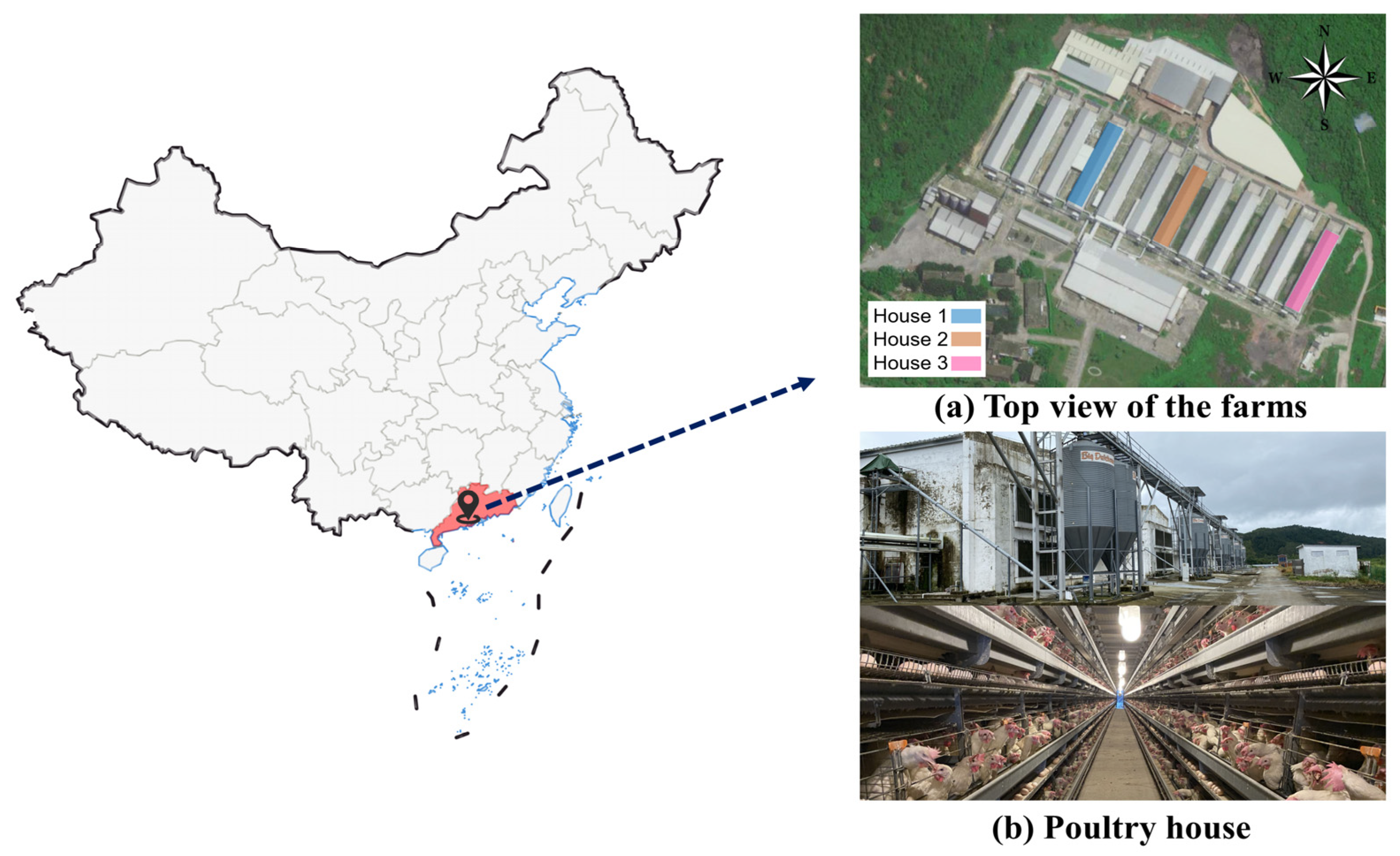
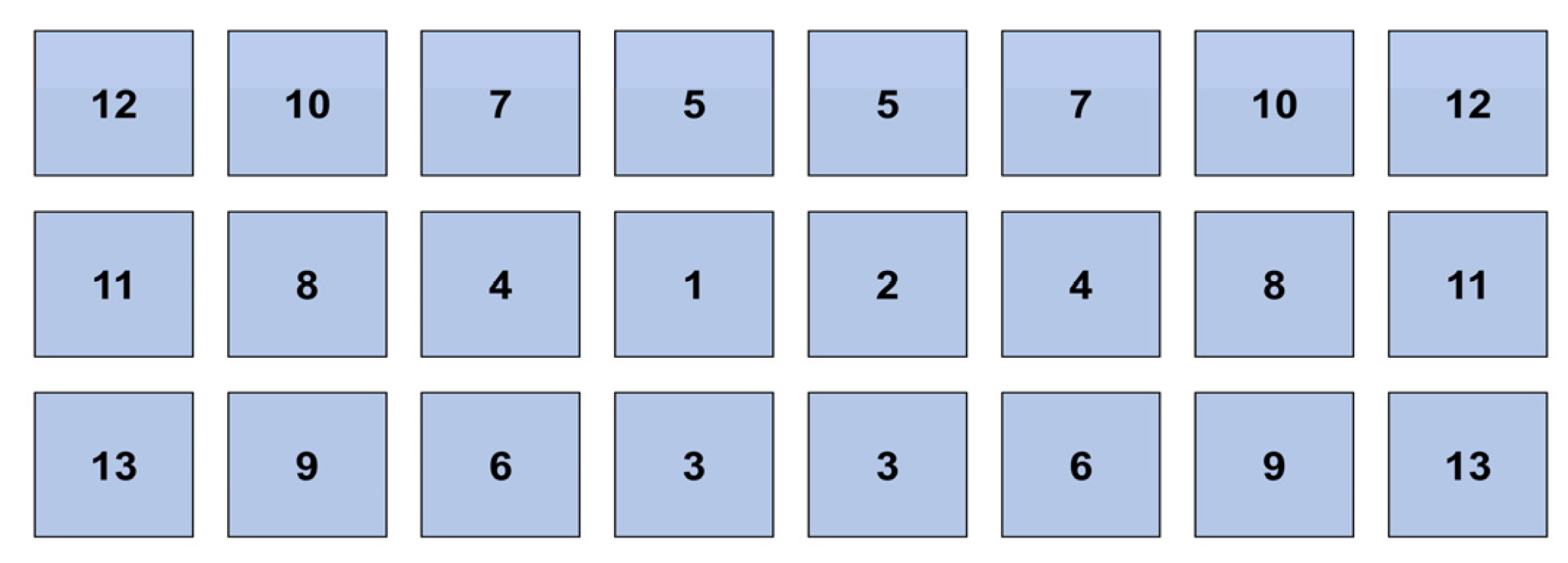

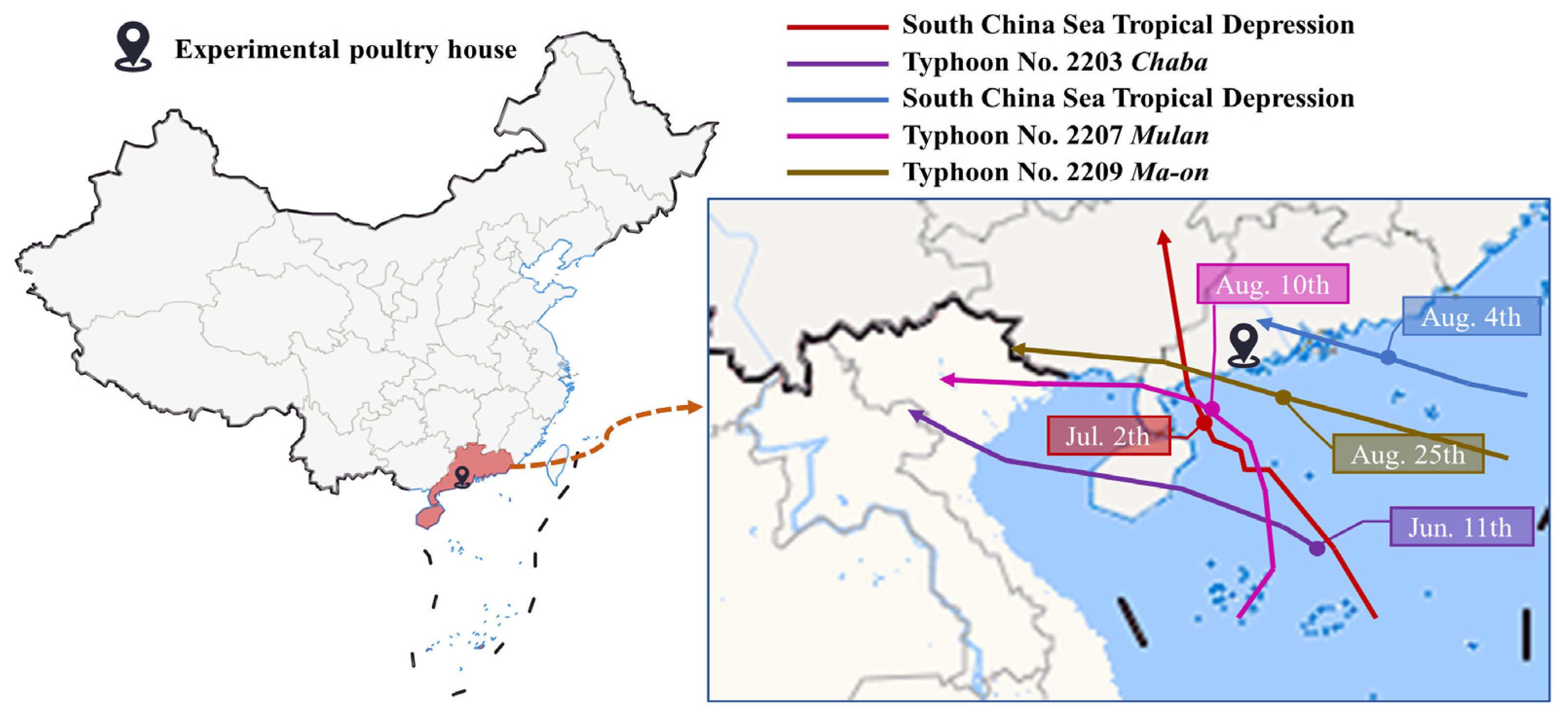

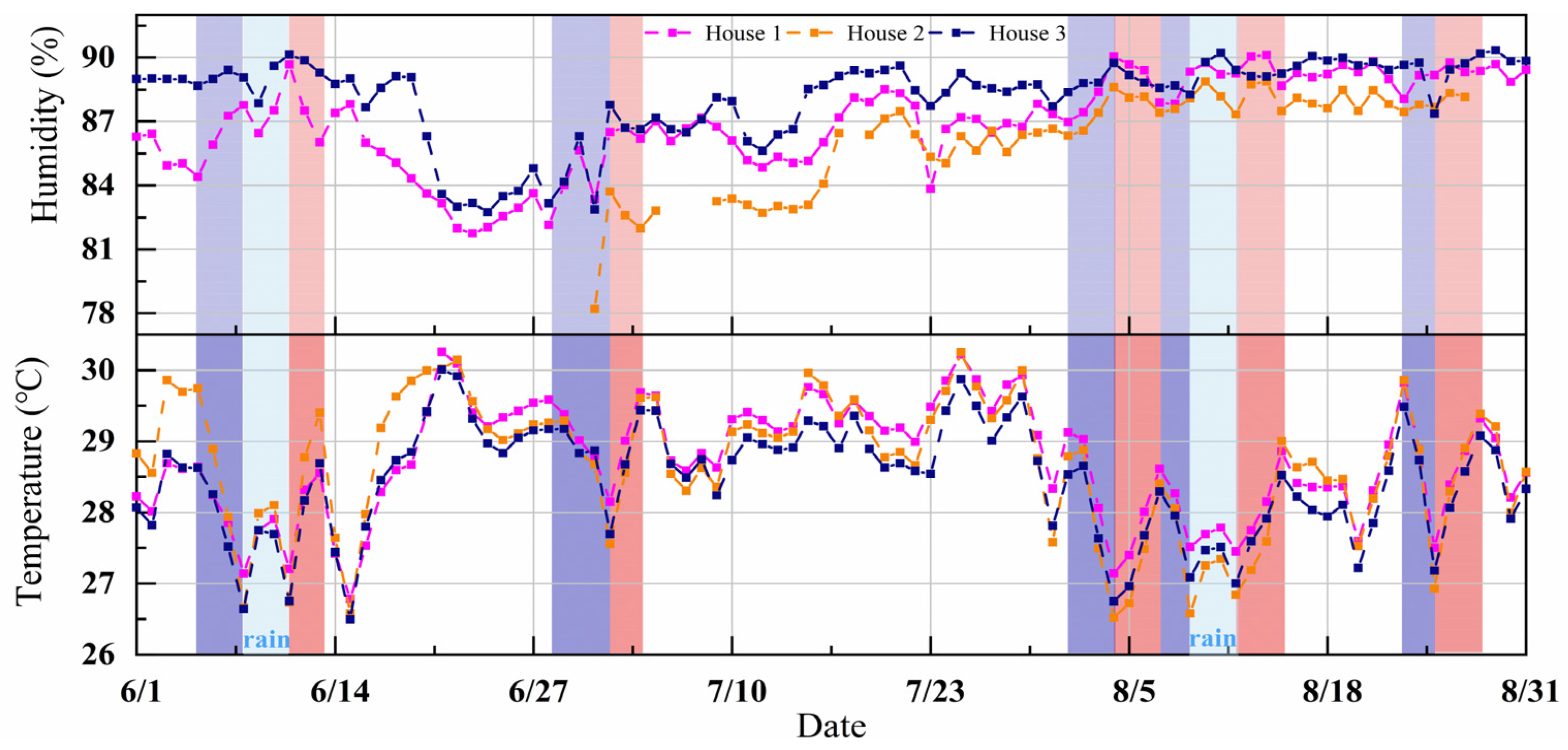
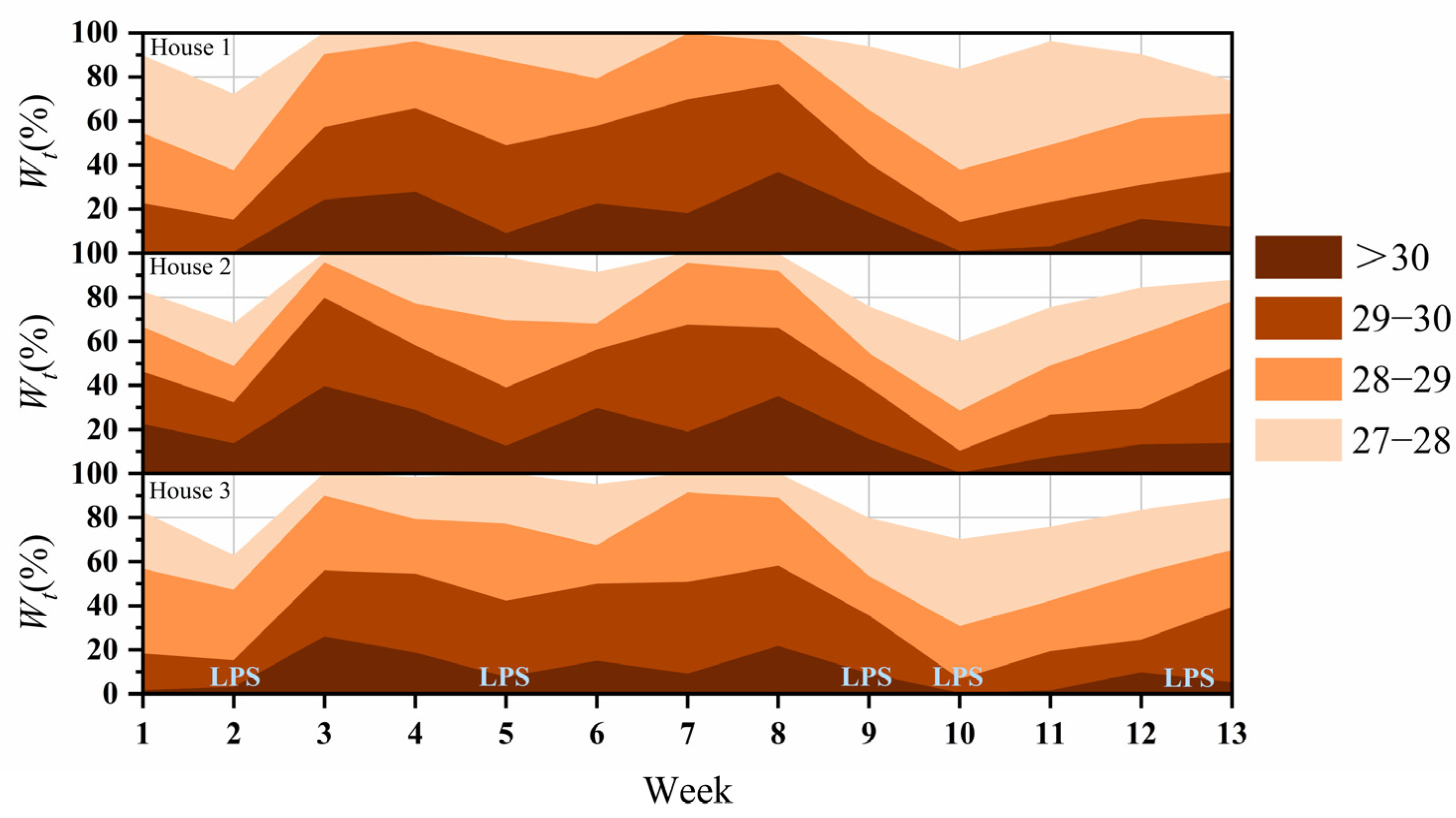
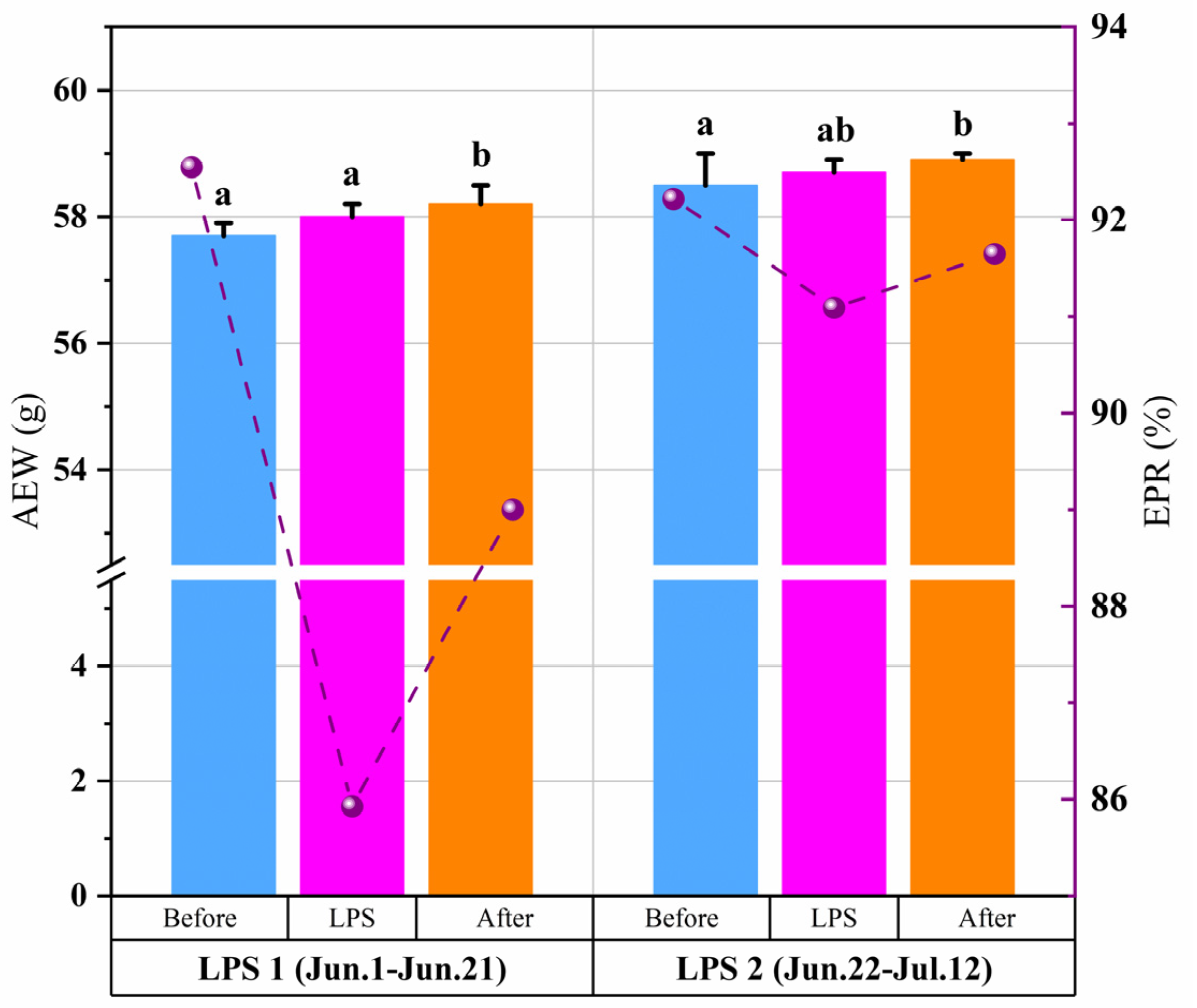
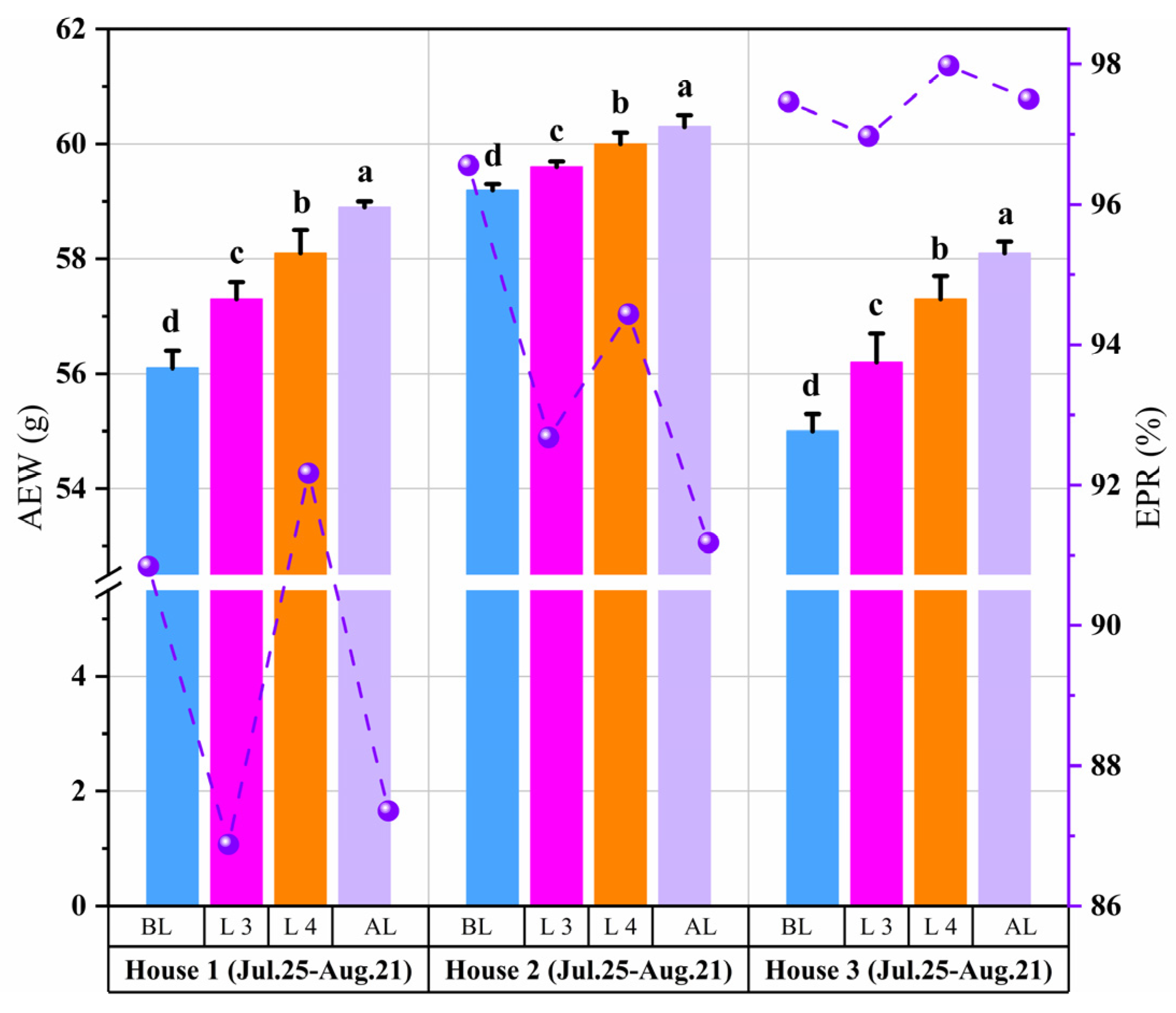
| Period | LPS 1 | LPS 2 | LPS 3 | LPS 4 | LPS 5 | p Value |
|---|---|---|---|---|---|---|
| Wt27 | −17.3% ± 2.0% a | 0.3% ± 1.3% c | −16.9% ± 7.6% a | −12.1% ± 2.8% ab | −1.1% ± 7.9% bc | 0.015 |
| Wt28 | −14.7% ± 3.6% c | −6.1% ± 2.9% d | −34.8% ± 2.4% a | −25.3% ± 1.9% b | 9.2% ± 5.3% e | 0.000 |
| Wt29 | −8.2% ± 4.5% b | −16.1% ± 2.9% b | −28.5% ± 5.6% a | −28.1% ± 1.0% a | 13.1% ± 5.3% c | 0.000 |
| Wt30 | −2.3% ± 4.6% b | −15.3% ± 3.2% a | −16.7% ± 3.1% a | −13.9% ± 3.7% a | −2.5% ± 2.3% b | 0.003 |
| Date | THI | Normal | Alert | Danger | Emergency | |
|---|---|---|---|---|---|---|
| House 1 | 24 August | 82.7 ± 1.9 | 0.0% | 0.0% | 67.2% | 32.8% |
| 25 August | 79.6 ± 1.1 | 0.0% | 36.2% | 62.8% | 0.0% | |
| 26 August | 81.5 ± 1.8 | 0.0% | 16.7% | 83.3% | 0.0% | |
| House 2 | 24 August | 82.4 ± 2.0 | 0.0% | 0.0% | 69.9% | 30.1% |
| 25 August | 80.1 ± 1.0 | 0.0% | 16.9% | 83.1% | 0.0% | |
| 26 August | 81.7 ± 1.6 | 0.0% | 0.0% | 100.0% | 0.0% | |
| House 3 | 24 August | 82.3 ± 1.9 | 0.0% | 0.0% | 70.8% | 29.2% |
| 25 August | 79.3 ± 1.3 | 0.0% | 45.8% | 54.2% | 0.0% | |
| 26 August | 81.1 ± 1.7 | 0.0% | 24.9% | 76.1% | 0.0% |
| Period | L 1 | p Value | L 2 | p Value | ||||
|---|---|---|---|---|---|---|---|---|
| Before | LPSs | After | Before | LPSs | After | |||
| FI (g) | 103.6 ± 3.4 b | 108.3 ± 1.8 a | 105.4 ± 3.3 ab | 0.025 | 104.9 ± 3.0 b | 108.9 ± 1.6 a | 105.9 ± 2.3 b | 0.015 |
| FCRe | 1.97 | 2.18 | 2.04 | – | 1.99 | 2.01 | 1.99 | – |
| Period | Before | L 3 | L 4 | After | p Value | |
|---|---|---|---|---|---|---|
| FI (g) | House 1 | 109.5 ± 2.2 c | 111.2 ± 0.8 b | 112.9 ± 0.9 a | 111.7 ± 1.2 a | 0.000 |
| House 2 | 106.5 ± 6.3 b | 111.4 ±2.7 ab | 115.8 ± 2.2 a | 110.9 ± 5.7 ab | 0.009 | |
| House 3 | 105.3 ± 2.4 b | 109.2 ± 4.0 ab | 112.6 ±2.8 a | 108.8 ± 5.3 ab | 0.013 | |
| FCRe | House 1 | 2.05 | 2.15 | 2.06 | 2.16 | – |
| House 2 | 1.99 | 2.08 | 2.06 | 2.09 | – | |
| House 3 | 1.90 | 2.05 | 2.01 | 1.96 | – | |
Disclaimer/Publisher’s Note: The statements, opinions and data contained in all publications are solely those of the individual author(s) and contributor(s) and not of MDPI and/or the editor(s). MDPI and/or the editor(s) disclaim responsibility for any injury to people or property resulting from any ideas, methods, instructions or products referred to in the content. |
© 2024 by the authors. Licensee MDPI, Basel, Switzerland. This article is an open access article distributed under the terms and conditions of the Creative Commons Attribution (CC BY) license (https://creativecommons.org/licenses/by/4.0/).
Share and Cite
Peng, H.; Wang, Y.; Zhang, Z.; Qin, W.; Li, B.; Zheng, W.; Yin, P.; Zhu, H. Effects of Low-Pressure Systems on Temperature, Humidity, Egg Production, and Feed Utilization Efficiency in Large-Scale Poultry Houses during Summer. Animals 2024, 14, 2554. https://doi.org/10.3390/ani14172554
Peng H, Wang Y, Zhang Z, Qin W, Li B, Zheng W, Yin P, Zhu H. Effects of Low-Pressure Systems on Temperature, Humidity, Egg Production, and Feed Utilization Efficiency in Large-Scale Poultry Houses during Summer. Animals. 2024; 14(17):2554. https://doi.org/10.3390/ani14172554
Chicago/Turabian StylePeng, Haiqing, Yang Wang, Zhihao Zhang, Wenxiang Qin, Baoming Li, Weichao Zheng, Peng Yin, and Hao Zhu. 2024. "Effects of Low-Pressure Systems on Temperature, Humidity, Egg Production, and Feed Utilization Efficiency in Large-Scale Poultry Houses during Summer" Animals 14, no. 17: 2554. https://doi.org/10.3390/ani14172554





